The large-scale import of inexpensive wood carvings from China and Southeast Asian countries over the past decade has made the lives of Taiwanese wood carvers difficult.
In Sanyi (
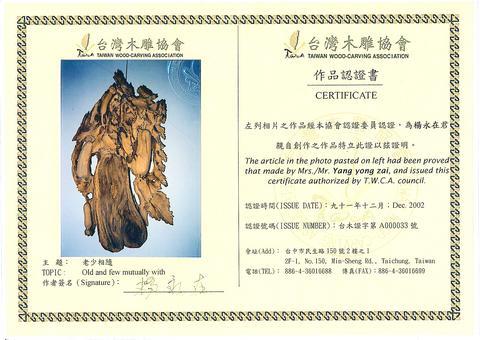
To differentiate between original Taiwanese wood carvings and the often mass produced versions on the market, the Taiwan Wood-carving Association (
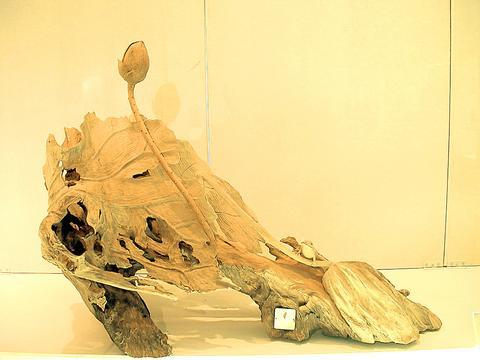
Wood carvings made in Taiwan range from several thousand NT dollars to several million, with most works costing from NT$30,000 to NT$150,000. A busy wood carver can earn around NT$2,000 a day. Chinese wood carvers typically earn 30 times less than this (around NT$67).
"A country's wood carvings gradually evolve from handicraft level to the level of art. Chinese wood carvings are still at the handicraft stage. What we see on the market are mostly factory-manufactured products. However, their low prices have caused Taiwanese wood carvers to suffer economically," said Yang Yung-tzai (
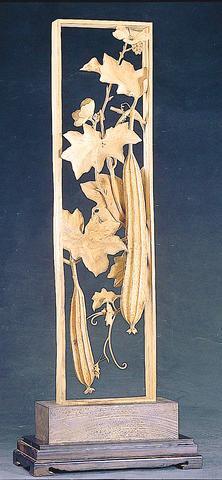
Association (TWCA).
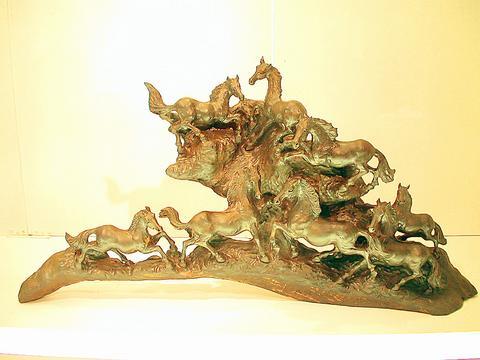
"Over the past decade, many local wood carvers have gone to China and set up factories there producing handicraft-level works. Those who did not go learned to refine their craft into works of art," Yang said.
There is also a large number of wood carvings of dubious origin sold at retail stores. Yang said that some of these are commissioned by local wood carvers to be produced by factories in China, while others are unauthorized Chinese imitations of works by popular local artists. One wood carver even submitted a Chinese-made work to participate in the National Literature and Art Achievement Award (
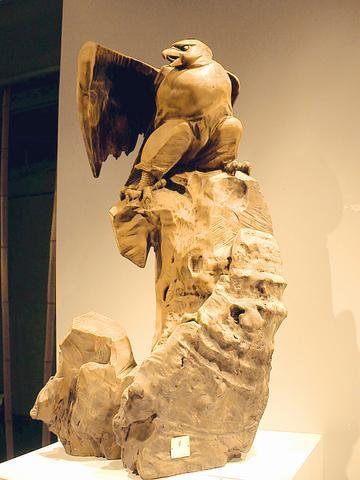
To help combat the problem of fakes, certificates of authenticity for wood carving works have been introduced by the TWCA to show that the works were made in the country, from start to finish, by a Taiwanese artist. They also detail the materials used. Though a neglected aspect for collectors, materials are important for pricing a work. Taiwanese beech timber, for example, is 20 times the price of its Vietnamese or Laotian counterparts.
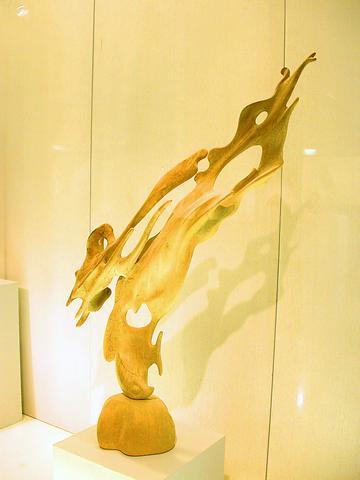
Faking it
In the past, the only proof of a wood carving's authenticity were privately printed certificates that some stores and artists attached to the works. The most widespread device to prove that a carving is genuine, however, is the autograph, which, Yang said, can easily be faked.
To get a certificate of authenticity, judges and wood craftsmen at TWCA examine the carving styles, techniques and "artistic spirit," to determine whether or not the work was made abroad. A copy of the certificate is kept at the association's office for the reference of doubtful buyers. The association has issued 200 certificates so far, each costing the creator NT$600. There is no refund for failed applications and less than 2 percent of applications fail to gain certification.
Shen Pei-tze (
"I used to give my buyers a certificate I made and I always carved my autograph on the works. But these can still be copied. Having a third party certificate for my works is a much better solution."
Others are not so sure. Lin Chin-chang (
For genuine artists, Lin went on, the best guarantee is the artists themselves. "If a wood carver has an unmistakable style, his or her name naturally becomes a brand, like Ju Ming (朱銘) in the sculpture circle. People recognize that brand."
Like most Sanyi wood carvers, Lin sells his works directly to collectors. So far, they have not required certificates from Lin. "I have been making wood carvings for over a decade, but the association has been around for less than a year. I think I am in a better position to guarantee my works."
Making it
Lin said there had been no disputes regarding the authenticity of his works so far.
Other well known wood carvers have come up with different ways to prove the authenticity of their works to collectors. Huang Ma-ching (
"A wood carving that has been featured at exhibitions has few problems with establishing its authenticity. I have had no authenticity troubles so far," said Huang, who nevertheless admitted there is a large number of copies of his works on the market.
The application fee, Huang said, discouraged him from applying for a certificate. "My works do not cater to the market, so that usually out of 100 works I have done, I can only sell a few of them. The situation is even worse these days because of the recession. Certificates may be a good thing for more commercial wood carvings, but it makes little difference to me."
Despite the mixed response, Yang is intent on making the system last.
"When Chinese factories stamp `Made in Taiwan' on their wood products to raise their price, issuing the certificates is an act of self-help," Yang said. "Both mass manufactured products and art crafts need guarantees of their origin and authenticity.
"We chose to keep our roots in Taiwan when others sought development in China. [Last year,] before the government did anything about the economic crisis we are facing, we launched this system to help ourselves."
But, six months after the launch of the certification scheme, government authorities are catching up. The Council for Cultural Affairs (
The certificate for ceramic works is scheduled to be launched at the end of this year, according to Lu Chia-ching, chief executive of the Chinese Ceramic Association (
Proving it
"Unlike wood carvings, the ceramic circle has seen few disputes over the origin of ceramic works, but there are confusing standards of quality. The certificate will mark those works deemed above standard quality," Lu said.
The TWCA, meanwhile, believes it is on to a good thing with the certification scheme, but needs to convince wood carving artists the idea is sound.
"What artists do not yet seem to understand is that this is a guarantee of their intellectual property rights. Collectors may not have doubts about the origin of their collection today, but a dispute may arise decades afterward. The wood carving circle needs to promote the protection of intellectual property rights," Yang said.

April 14 to April 20 In March 1947, Sising Katadrepan urged the government to drop the “high mountain people” (高山族) designation for Indigenous Taiwanese and refer to them as “Taiwan people” (台灣族). He considered the term derogatory, arguing that it made them sound like animals. The Taiwan Provincial Government agreed to stop using the term, stating that Indigenous Taiwanese suffered all sorts of discrimination and oppression under the Japanese and were forced to live in the mountains as outsiders to society. Now, under the new regime, they would be seen as equals, thus they should be henceforth

The 1990s were a turbulent time for the Chinese Nationalist Party’s (KMT) patronage factions. For a look at how they formed, check out the March 2 “Deep Dives.” In the boom years of the 1980s and 1990s the factions amassed fortunes from corruption, access to the levers of local government and prime access to property. They also moved into industries like construction and the gravel business, devastating river ecosystems while the governments they controlled looked the other way. By this period, the factions had largely carved out geographical feifdoms in the local jurisdictions the national KMT restrained them to. For example,

With over 100 works on display, this is Louise Bourgeois’ first solo show in Taiwan. Visitors are invited to traverse her world of love and hate, vengeance and acceptance, trauma and reconciliation. Dominating the entrance, the nine-foot-tall Crouching Spider (2003) greets visitors. The creature looms behind the glass facade, symbolic protector and gatekeeper to the intimate journey ahead. Bourgeois, best known for her giant spider sculptures, is one of the most influential artist of the twentieth century. Blending vulnerability and defiance through themes of sexuality, trauma and identity, her work reshaped the landscape of contemporary art with fearless honesty. “People are influenced by

The remains of this Japanese-era trail designed to protect the camphor industry make for a scenic day-hike, a fascinating overnight hike or a challenging multi-day adventure Maolin District (茂林) in Kaohsiung is well known for beautiful roadside scenery, waterfalls, the annual butterfly migration and indigenous culture. A lesser known but worthwhile destination here lies along the very top of the valley: the Liugui Security Path (六龜警備道). This relic of the Japanese era once isolated the Maolin valley from the outside world but now serves to draw tourists in. The path originally ran for about 50km, but not all of this trail is still easily walkable. The nicest section for a simple day hike is the heavily trafficked southern section above Maolin and Wanshan (萬山) villages. Remains of